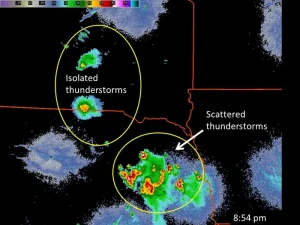Meteorologists would generally agree that summer is the most challenging time of year for making accurate rain forecasts.

During summer, there generally is enough moisture and atmospheric instability to help fuel the development of rain showers. Scattered thunderstorms are one of the most difficult weather events to forecast.
Thunderstorm development also is difficult to pinpoint in the summer. Summer thunderstorms sometimes develop from subtle outflow boundaries from previous thunderstorms, sea-breeze fronts, higher terrain or localized solar heating.
Numerical weather prediction models help define areas where conditions will be right for the development of thunderstorms.
These models are designed to calculate atmospheric conditions over a large area but cannot pinpoint the locations of a particular thunderstorm development. Summer thunderstorm forecasts are often broad, using terms like “isolated” and “scattered.”
“Isolated” corresponds with a 10% chance of measurable precipitation (0.01 inches or greater). “Scattered” indicates that there will be 30% to 50% coverage of convective weather, such as thunderstorms, in the forecast zone. “Widely scattered” is used for a forecast of 20% coverage. If you are planning outdoor activities and the chances of rain are 10% to 20%, it is a good idea to have backup plans for moving indoors.
Along with numerical models, satellites and ground based radars contribute a significant amount of additional information for forecasters as the storms develop. It is wise to have a weather radar app on your smartphone to see whether any thunderstorms are nearby.
The National Weather Service issues a severe thunderstorm warning when a thunderstorm is producing wind gusts of at least 58 miles per hour or hail of at least 1 inch in diameter.
If a tornado is detected, a tornado warning will be issued either in replacement of or concurrently with the existing severe thunderstorm warning. Severe thunderstorm warnings should not be ignored, as severe thunderstorms are dangerous and occasionally deadly.
Steve Ackerman and Jonathan Martin, professors in the UW-Madison Department of Atmospheric and Oceanic Sciences, are guests on WHA radio (970 AM) at noon the last Monday of each month. Send them your questions at stevea@ssec.wisc.edu or jemarti1@wisc.edu.

